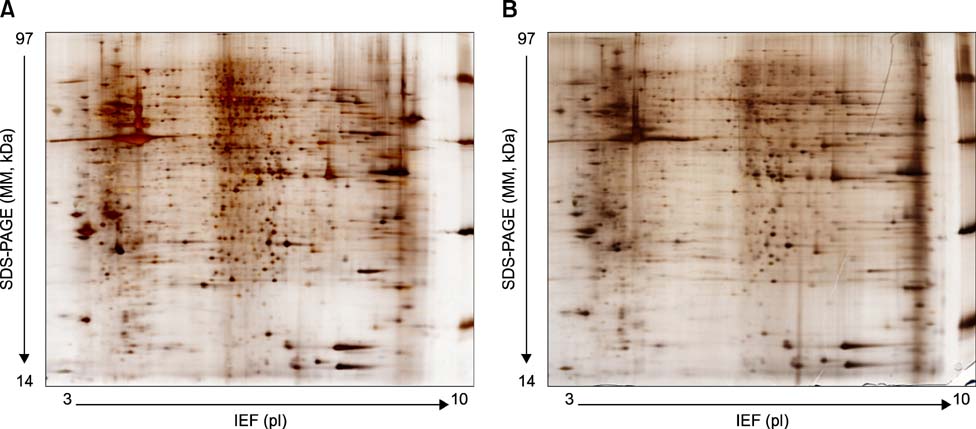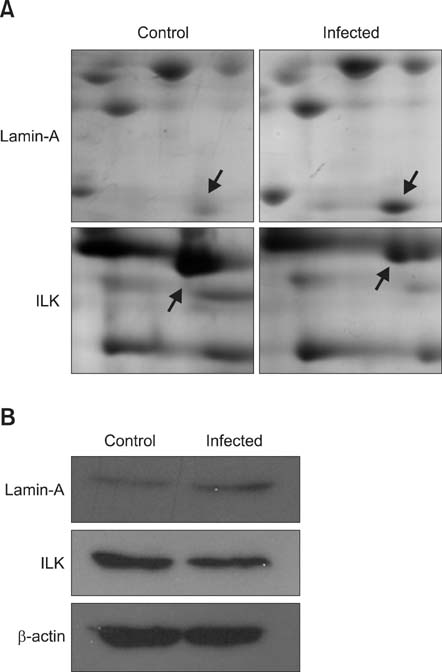J Vet Sci.
2014 Dec;15(4):511-517. 10.4142/jvs.2014.15.4.511.
Proteomic analysis of chicken peripheral blood mononuclear cells after infection by Newcastle disease virus
- Affiliations
-
- 1Laboratory of Infectious Diseases, College of Veterinary Medicine, Jilin University, Changchun 130062, China. dingzhuangjlu@126.com
- 2Engineering Research Center of Jilin Province for Animals Probiotics, College of Animal Science and Technology, Jilin Agricultural University, Changchun 130118, China.
- 3Shanghai Veterinary Research Institute, Chinese Academy of Agricultural Sciences, Shanghai 200241, China.
- 4Animal Infectious Disease Laboratory, College of Veterinary Medicine, Yangzhou University, Yangzhou 225009, China.
- 5Engineering Research Center of Chinese Ministry of Education for Edible and Medicinal Fungi, Jilin Agricultural University, Changchun 130118, China.
- KMID: 2070237
- DOI: http://doi.org/10.4142/jvs.2014.15.4.511
Abstract
- Characteristic clinical manifestations of Newcastle disease include leukopenia and immunosuppression. Peripheral blood mononuclear cells (PBMCs) are the main targets of Newcastle disease virus (NDV) infection. To survey changes in proteomic expression in chicken PBMCs following NDV infection, PBMC proteins from 30 chickens were separated using two-dimensional electrophoresis (2-DE) and subjected to mass spectrometry analysis. Quantitative intensity analysis showed that the expression of 78 proteins increased more than two-fold. Thirty-five proteins exhibited consistent changes in expression and 13 were identified as unique proteins by matrix assisted laser desorption ionization-time of flight mass spectrometer/mass spectrometer including three that were down-regulated and 10 that were up-regulated. These proteins were sorted into five groups based on function: macromolecular biosynthesis, cytoskeleton organization, metabolism, stress responses, and signal transduction. Furthermore, Western blot analysis confirmed the down-regulation of integrin-linked kinase expression and up-regulation of lamin A production. These data provide insight into the in vivo response of target cells to NDV infection at the molecular level. Additionally, results from this study have helped elucidate the molecular pathogenesis of NDV and may facilitate the development of new antiviral therapies as well as innovative diagnostic methods.
MeSH Terms
-
Animals
Avian Proteins/*genetics/metabolism
*Chickens
*Gene Expression Regulation
Leukocytes, Mononuclear/enzymology/virology
Newcastle Disease/*genetics/virology
Newcastle disease virus/*physiology
Poultry Diseases/*genetics/virology
*Proteome
Specific Pathogen-Free Organisms
Spectrometry, Mass, Matrix-Assisted Laser Desorption-Ionization/veterinary
Tandem Mass Spectrometry/veterinary
Avian Proteins
Proteome
Figure
Reference
-
1. Aldous EW, Alexander DJ. Newcastle disease in pheasants (Phasianus colchicus): a review. Vet J. 2008; 175:181–185.2. Chambers P, Millar NS, Bingham RW, Emmerson PT. Molecular cloning of complementary DNA to Newcastle disease virus, and nucleotide sequence analysis of the junction between the genes encoding the haemagglutinin-neuraminidase and the large protein. J Gen Virol. 1986; 67:475–486.
Article3. Davidson WS, Hazlett T, Mantulin WW, Jonas A. The role of apolipoprotein AI domains in lipid binding. Proc Natl Acad Sci U S A. 1996; 93:13605–13610.4. Didelot C, Schmitt E, Brunet M, Maingret L, Parcellier A, Garrido C. Heat shock proteins: endogenous modulators of apoptotic cell death. Handb Exp Pharmacol. 2006; 172:171–198.
Article5. Ding Z, Li ZJ, Zhang XD, Li YG, Liu CJ, Zhang YP, Li Y. Proteomic alteration of Marc-145 cells and PAMs after infection by porcine reproductive and respiratory syndrome virus. Vet Immunol Immunopathol. 2012; 145:206–213.
Article6. Esfandiarei M, Suarez A, Amaral A, Si X, Rahmani M, Dedhar S, McManus BM. Novel role for integrin-linked kinase in modulation of coxsackievirus B3 replication and virus-induced cardiomyocyte injury. Circ Res. 2006; 99:354–361.
Article7. Fauquet CM, Fargette D. International Committee on Taxonomy of Viruses and the 3,142 unassigned species. Virol J. 2005; 2:64.
Article8. Gruenbaum Y, Wilson KL, Harel A, Goldberg M, Cohen M. Review: nuclear lamins-structural proteins with fundamental functions. J Struct Biol. 2000; 129:313–323.
Article9. Handschumacher RE, Harding MW, Rice J, Drugge RJ, Speicher DW. Cyclophilin: a specific cytosolic binding protein for cyclosporin A. Science. 1984; 226:544–547.
Article10. Hannigan G, Troussard AA, Dedhar S. Integrin-linked kinase: a cancer therapeutic target unique among its ILK. Nat Rev Cancer. 2005; 5:51–63.
Article11. Harris TK, Cole RN, Comer FI, Mildvan AS. Proton transfer in the mechanism of triosephosphate isomerase. Biochemistry. 1998; 37:16828–16838.
Article12. Kamath S, Lip GY. Fibrinogen: biochemistry, epidemiology and determinants. QJM. 2003; 96:711–729.
Article13. Kasyapa CS, Kunapuli P, Cowell JK. Mass spectroscopy identifies the splicing-associated proteins, PSF, hnRNP H3, hnRNP A2/B1, and TLS/FUS as interacting partners of the ZNF198 protein associated with rearrangement in myeloproliferative disease. Exp cell Res. 2005; 309:78–85.
Article14. Kobayashi K, Ohgitani E, Tanaka Y, Kita M, Imanishi J. Herpes simplex virus-induced expression of 70 kDa heat shock protein (HSP70) requires early protein synthesis but not viral DNA replication. Microbiol Immunol. 1994; 38:321–325.
Article15. Lam KM. Growth of Newcastle disease virus in chicken macrophages. J Comp Pathol. 1996; 115:253–263.
Article16. Lam KM. Newcastle disease virus-induced apoptosis in the peripheral blood mononuclear cells of chickens. J Comp Pathol. 1996; 114:63–71.
Article17. Lam KM, Kabbur MB, Eiserich JP. Newcastle disease virus-induced functional impairments and biochemical changes in chicken heterophils. Vet Immunol Immunopathol. 1996; 53:313–327.
Article18. Lazebnik YA, Takahashi A, Moir RD, Goldman RD, Poirier GG, Kaufmann SH, Earnshaw WC. Studies of the lamin proteinase reveal multiple parallel biochemical pathways during apoptotic execution. Proc Natl Acad Sci U S A. 1995; 92:9042–9046.
Article19. Liu N, Song W, Wang P, Lee K, Chan W, Chen H, Cai Z. Proteomics analysis of differential expression of cellular proteins in response to avian H9N2 virus infection in human cells. Proteomics. 2008; 8:1851–1858.
Article20. Lowenstein CJ. Integrin-linked kinase plays a key role in coxsackievirus replication. Circ Res. 2006; 99:346–347.
Article21. Mathesius U, Keijzers G, Natera SH, Weinman JJ, Djordjevic MA, Rolfe BG. Establishment of a root proteome reference map for the model legume Medicago truncatula using the expressed sequence tag database for peptide mass fingerprinting. Proteomics. 2006; 1:1424–1440.
Article22. Meighan-Mantha RL, Tolan DR. Noncoordinate changes in the steady-state mRNA expressed from aldolase A and aldolase C genes during differentiation of chicken myoblasts. J Cell Biochem. 1995; 57:423–431.
Article23. Miller PJ, Decanini EL, Afonso CL. Newcastle disease: evolution of genotypes and the related diagnostic challenges. Infect Genet Evol. 2010; 10:26–35.
Article24. Miralles F, Visa N. Actin in transcription and transcription regulation. Curr Opin Cell Biol. 2006; 18:261–266.
Article25. Roulston A, Marcellus RC, Branton PE. Viruses and apoptosis. Annu Rev Microbiol. 1999; 53:577–628.
Article26. Shiojima I, Walsh K. Role of Akt signaling in vascular homeostasis and angiogenesis. Circ Res. 2002; 90:1243–1250.
Article27. Stuurman N, Heins S, Aebi U. Nuclear lamins: their structure, assembly, and interactions. J Struct Biol. 1998; 122:42–66.
Article28. Taipale M, Jarosz DF, Lindquist S. HSP90 at the hub of protein homeostasis: emerging mechanistic insights. Nat Rev Mol Cell Biol. 2010; 11:515–528.
Article29. van der Pouw Kraan TCMT, Kasperkovitz PV, Verbeet N, Verweij CL. Genomics in the immune system. Clin Immunol. 2004; 111:175–185.
Article30. Wang J, Ying G, Wang J, Jung Y, Lu J, Zhu J, Pienta KJ, Taichman RS. Characterization of phosphoglycerate kinase-1 expression of stromal cells derived from tumor microenvironment in prostate cancer progression. Cancer Res. 2010; 70:471–480.
Article31. White SR, Williams P, Wojcik KR, Sun S, Hiemstra PS, Rabe KF, Dorscheid DR. Initiation of apoptosis by actin cytoskeletal derangement in human airway epithelial cells. Am J Respir Cell Mol Biol. 2001; 24:282–294.
Article32. Wilhelm AJ, Zabalawi M, Grayson JM, Weant AE, Major AS, Owen J, Bharadwaj M, Walzem R, Chan L, Oka K, Thomas MJ, Sorci-Thomas MG. Apolipoprotein A-I and its role in lymphocyte cholesterol homeostasis and autoimmunity. Arterioscler Thromb Vasc Biol. 2009; 29:843–849.
Article33. Xu C, Meng S, Liu X, Sun L, Liu W. Chicken cyclophilin A is an inhibitory factor to influenza virus replication. Virol J. 2010; 7:372.
Article34. Yuan W, Xie J, Long C, Erdjument-Bromage H, Ding X, Zheng Y, Tempst P, Chen S, Zhu B, Reinberg D. Heterogeneous nuclear ribonucleoprotein L is a subunit of human KMT3a/Set2 complex required for H3 Lys-36 trimethylation activity in vivo. J Biol Chem. 2009; 284:15701–15707.
Article
- Full Text Links
- Actions
-
Cited
- CITED
-
- Close
- Share
- Similar articles
-
- Red blood cell elution time of strains of Newcastle disease virus
- Modulation of Humoral and Cell-Mediated Immunity Against Avian Influenza and Newcastle Disease Vaccines by Oral Administration of Salmonella enterica Serovar Typhimurium Expressing Chicken Interleukin-18
- Preparation and diagnostic utility of a hemagglutination inhibition test antigen derived from the baculovirus-expressed hemagglutinin-neuraminidase protein gene of Newcastle disease virus
- Characterization of Lentogenic Newcastle Disease Virus Isolated in Jeju, Korea during 2007~2008 Surveillance
- Cloning and Expression of Hemagglutinin-Neuraminidase Gene of a Thermostable Isolate of Newcastle Disease Virus by Baculovirus Recombinants




